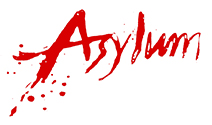I watched ‘One flew over the cuckoo’s nest’ last night…I first watched the film in the late 1980s when I was at University in Greece…the film came out in 1975 and was an adaptation of a book that was written in the early 1960s…I had forgotten how brilliantly powerful this film is…a timeless indictment of psychiatric oppression and abuse of power…

…but at the same time a timeless celebration of humanity, compassion and the free, fighting, transgressive and unrelenting human spirit within an inhumane, spirit-crushing and totally untherapeutic mental institution. When I watched the film first time in my 20s in Greece, I could not have known that I was to encounter (sadly) not that dissimilar conditions of psychiatric oppression and abuse of power, as well as of lack of humanity, compassion and therapeutic care, within a soul-destroying and spirit-crushing acute mental health ward in North Manchester 20 years later…I could not have known that in that spirit-crushing acute mental health ward 20 years later I was to meet humanity and compassion solely in my encounters with the Occupational Therapy technician I did art with and his boss, the Occupational Therapist I got to work with for 6 weeks after I was discharged…lastly, I could not have known that during my detention on the acute ward 20 years later I was to witness the fighting, transgressive and unrelenting human spirit in action-my own fighting spirit…
I found the following synopsis of ‘One flew over the cuckoo’s nest’ in New York Times:
‘With an insane asylum standing in for everyday society, Milos Forman‘s 1975 film adaptation of Ken Kesey‘s novel is a comically sharp indictment of the Establishment urge to conform. Playing crazy to avoid prison work detail, manic free spirit Randle P. McMurphy (Jack Nicholson) is sent to the state mental hospital for evaluation. There he encounters a motley crew of mostly voluntary inmates, including cowed mama’s boy Billy (Brad Dourif) and silent Native American Chief Bromden (Will Sampson), presided over by the icy Nurse Ratched (Louise Fletcher). Ratched and McMurphy recognize that each is the other’s worst enemy: an authority figure who equates sanity with correct behavior, and a misfit who is charismatic enough to dismantle the system simply by living as he pleases. McMurphy proceeds to instigate group insurrections large and small, ranging from a restorative baseball game to an unfettered afternoon boat trip and a tragic after-hours party with hookers and booze. Nurse Ratched, however, has the machinery of power on her side to ensure that McMurphy will not defeat her. Still, McMurphy’s message to live free or die is ultimately not lost on one inmate, revealing that escape is still possible even from the most oppressive conditions’.
Watching ‘One flew over the cuckoo’s nest’ last night, I thought the entire film is superb; but there were certain scenes, stills and moments in the film that had a particular poignancy for me…that touched me deeply on a cognitive and an affective level and brought back memories from the time of my detention on the acute mental health ward 4 years ago…

This still depicts the exterior of the mental institution in Oregon, USA where the film is set. The high barbed wire fence surrounding the institution made me think of prisons and prison inmates. Although there was not a high barbed wire fence surrounding the mental health facility where I was detained, I experienced my hospitalisation/detention/deprivation of liberty very much as imprisonment; long after I was discharged and whilst back at work, I gave a conference paper on my identity struggles as a service user researcher where I indicated that I would be comfortable with describing myself as an ‘ex-inmate’.
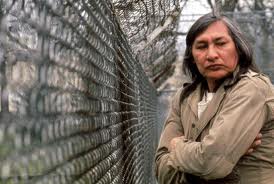
The high and thick barbed wire fence surrounding the mental institution of the film- the ‘cuckoo’s nest’- dominates this still. What struck me in particular was the expression on the Native American patient’s face and his body language. I thought I could detect sadness, helplessness, hopelessness…emotions probably brought about (I thought) by the absence of any prospect or possibility of a future life outside the institution…by the realisation of the impossibility of escape from it…by a sense of entrapment. When I was detained in North Manchester General Hospital back in 2009, I kept saying that I did not think I would ever get out of hospital or I would ever get better, which reflects my profound feelings of helplessness and hopelessness at the time.
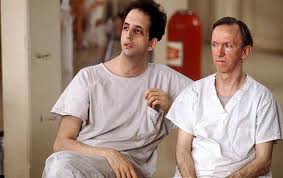
Emaciated figures of psychiatric patients in hospital gowns…acutely agitated and terrified or completely emotionless and apathetic…zombified through heavy medication and electro-shocks…moving around like ghosts and smoking endlessly…I lived among such ghosts – a ghost myself- for 3 months back in 2009 whilst detained in hospital…
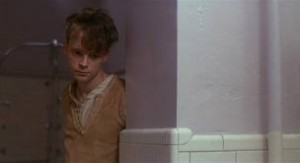
Billy, one of the patients in the ‘cuckoo’s nest’…he had a very bad stutter and had attempted suicide, possibly more than once…he actually killed himself towards the end of the film…Billy reminded me of my own suicidality back in 2008-2009…
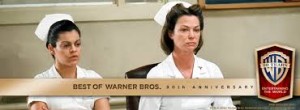
The nurses in the film – and at the acute mental health ward where I was detained alike-rarely (if at all) engaged meaningfully and therapeutically with the patients; in both contexts the nursing staff’s interactions with the patients occurred mainly during the administration of medication and during the enforcement of order…I remember staff mainly sitting in the nurses’ office and talking, eating and drinking coffee or looking at a computer when they were not giving out medication…the nurses in the film were also to be found mainly at the nurses’ station, a space where patients were forbidden. From my case records it appears that whilst on the acute mental health ward, I was very agitated, acutely distressed and constantly knocking on the nurses’ office door to tell staff that I wanted to go home or that I wanted to go to the vending machine outside the ward. Staff apparently perceived me as ‘intrusive’- it seems that my acute agitation and distress was construed as a kind of childlike ‘intrusion’, an irritation, by those very people supposedly responsible for alleviating and containing my distress. As a result, I was sent to my room (to have ‘a time out’) or, in a few instances, I was physically restrained. I now wonder whether the absence of nursing staff’s meaningful engagement with the patients was – partly at least – due to staff’s own inability to tolerate acute mental distress and their ensuing need to defensively detach themselves from it as a way of self- protection…the nurses’ high levels of detachment and lack of warmth and compassion in the film could possibly be due to a similar need for defensive self-protection from the patients’ madness and distress whilst order in the institution was preserved…
In the film, McMurphy (Jack Nickolson) instigates a number of insurrections and acts of resistance to the inhumane, spirit-crushing and totally untherapeutic regime of the mental institution… in these acts of resistance the other patients participate too…McMurphy shows humanity and compassion for others in his resistance…and he becomes the incarnation of the free, fighting, transgressive and unrelenting human spirit within that regime…

Absconding from the hospital as an act of resistance
This still depicts McMurphy absconding from the hospital where he was committed by climbing the high and thick barbed wire fence surrounding the mental institution with the help of the Native American patient…I too absconded twice from the acute ward where I was detained…I absconded twice in the same week during the first month of my detention…I still managed to abscond even though I was on close observation, heavily medicated, very distressed and so disorientated that I did not really know where the hospital was in relation to familiar areas of Manchester. The hospital was in north Manchester and I lived in south Manchester at the time – almost 2 hours from the hospital on public transport. The first time I absconded (which I don’t remember) I apparently managed to get the bus from the hospital and go to Manchester Piccadilly station and then go home! The second time was night time and I remember it; I got into a taxi, paid £10 and went home quite late. Even though both times I absconded anything could have happened to me – I could have been run over by a car or I could have killed myself – my absconding could be seen as an act of resistance to the inhumane, oppressive, spirit-crushing and totally untherapeutic regime of the mental health ward…it could be seen as a manifestation of my own fighting, transgressive and unrelenting spirit…
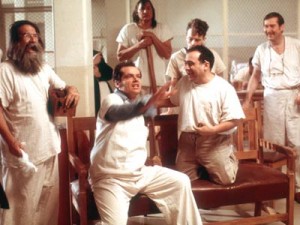
McMurphy is pretending to watch on the TV and be a commentator for a baseball game whilst surrounded by animated fellow patients- an act of resistance given that watching baseball on the TV was categorically forbidden for the patients
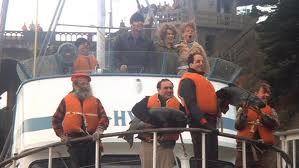
McMurphy took his fellow patients on a fishing boat trip – another act of resistance as it represented a major transgression of the rules of the mental institution
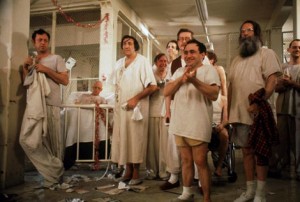
The patients are looking amused and animated following an after hours Christmas party with alcohol and women that McMurphy organised – another major transgression of the rules of the mental institution
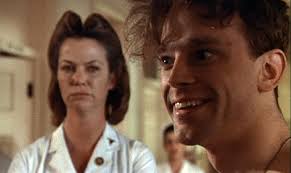
Billy, the suicidal stutterer, is looking elated following a night of pleasure and intimacy he spent with his date, a woman McMurphy introduced him to during the after hours Christmas party; Nurse Ratched is disapproving strongly of Billy’s date and elation; the ultimate transgression of the rules of the regime has been committed…
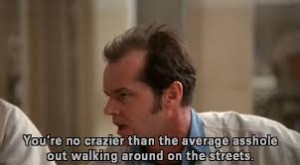
McMurphy is telling his fellow patients ‘You’re no crazier than the average asshole out walking around on the streets!’ One could argue that this is a rather transgressive statement which could be seen as questioning the legitimacy of these patients’ diagnosis as ‘crazy’ (mentally ill) and consequently the legitimacy of their confinement to a mental institution.
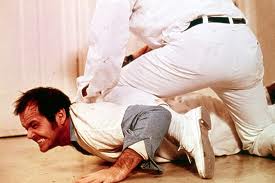
McMurphy is being subjected to physical restraint…or ‘Care and Control’ as it is referred to nowadays…in the film physical restraint is normally used on McMurphy after he has broken a rule of the regime…to control and punish him…apparently, I was physically restrained in a few occasions when I was detained in hospital…according to my care records I was very agitated, acutely distressed and constantly knocking on the nurses’ office door to tell staff that I wanted to go home or that I wanted to go to the vending machine outside the ward. Staff apparently perceived me as ‘intrusive’- my acute agitation and distress was construed as a kind of childlike ‘intrusiveness’, an irritation for the nurses. As a result, I was sent to my room (to have ‘a time out’) or, in a few instances, I was physically restrained…unnecessary use of physical restraint as a means of controlling acute agitation and distress (‘intrusiveness’) in my case?
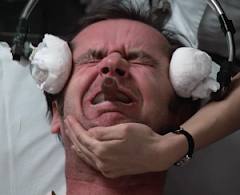
McMurphy is being subjected to electro-convulsive therapy (ECT) whilst fully awake…apparently, the luxury of sedation was not available during ECT treatments at the time the film came out…the excruciating pain is evident on McMurphy’s face…in the film ECT is normally used on McMurphy and other patients after they have broken a rule of the regime…to punish, control, mollify them and crush their spirit…ECT was considered in my case before I was admitted to hospital, whilst I was detained in hospital and after I was discharged… eventually ECT was abandoned as a possible treatment of my severe depression…I strongly refused to have ECT whenever I was asked…but the thought that I could have been given ECT whilst detained in hospital (even without my consent and in ‘my best interests’) terrifies me…I now have an Advance Directive specifying that I do not wish to have ECT, a barbaric treatment with very severe side effects, under any circumstances!
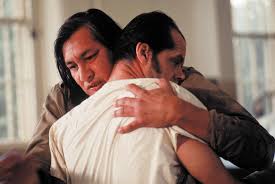
Finally, in this still McMurphy has had a lobotomy and he is in a vegetative state…the Native American patient embracing him said that McMurphy is now ‘like one of those dummies, where there is nothing behind their mask-like face’…the lobotomy has left McMurphy with nothing…nothing of his free, fighting, transgressive and unrelenting spirit…similarly to physical restraint and ECT, lobotomy features in the film as a means of punishment, social control and spirit-crushing following the breaking of important rules of the psychiatric regime.
